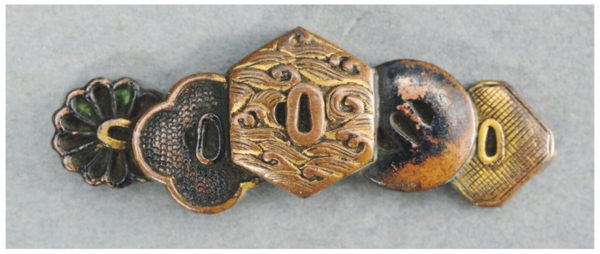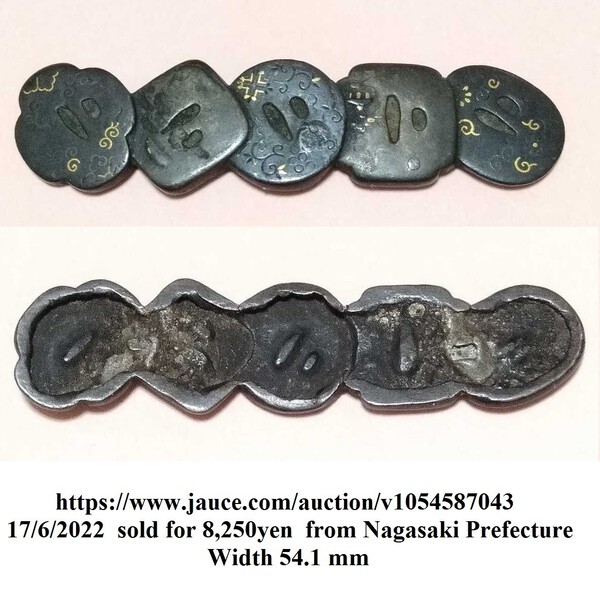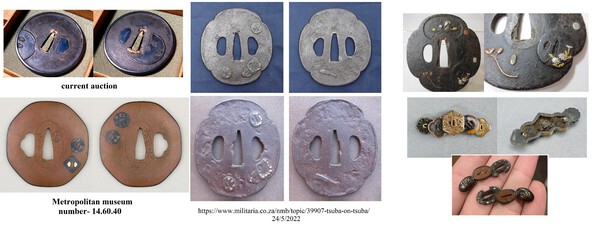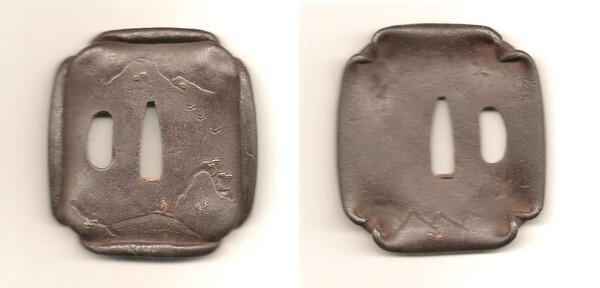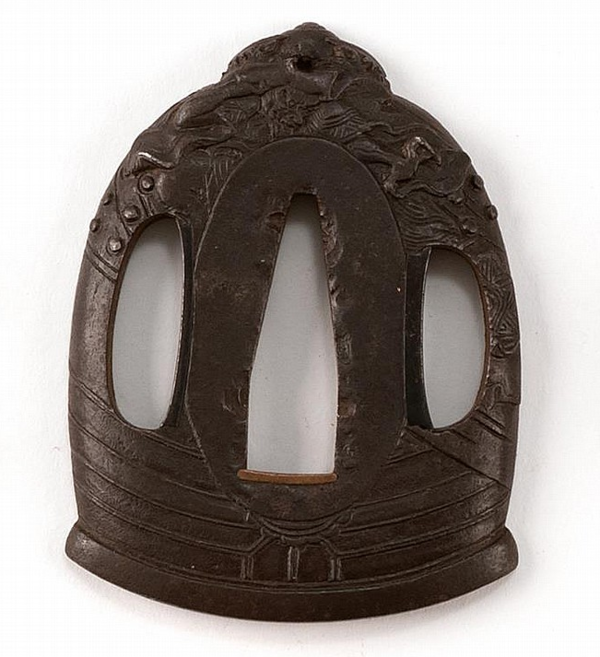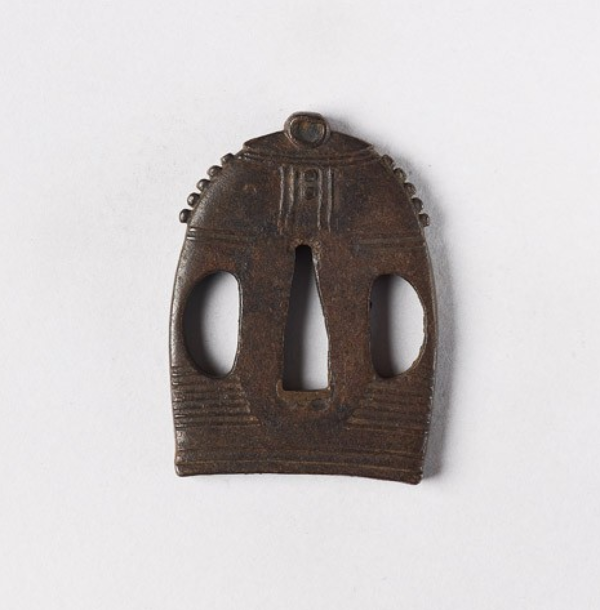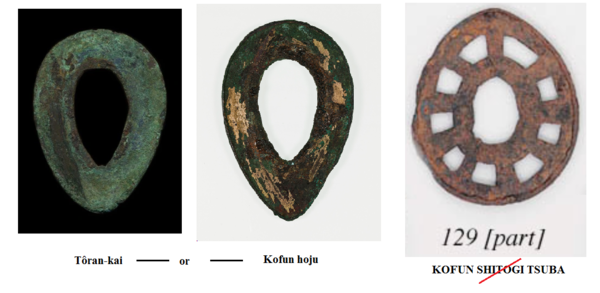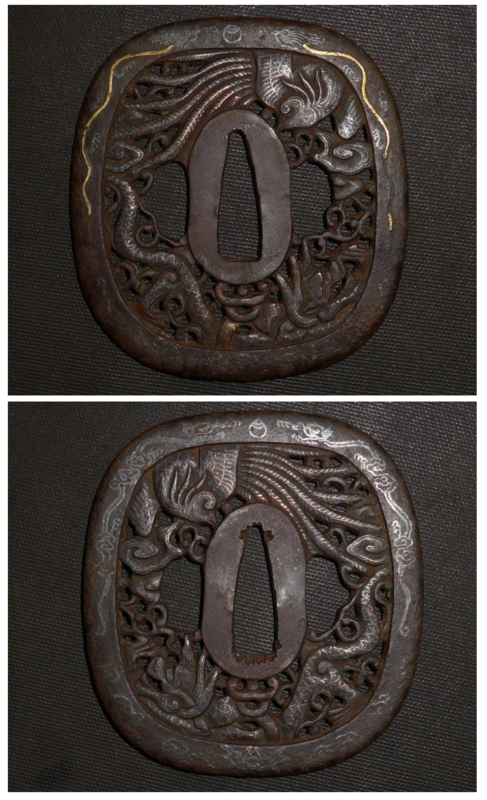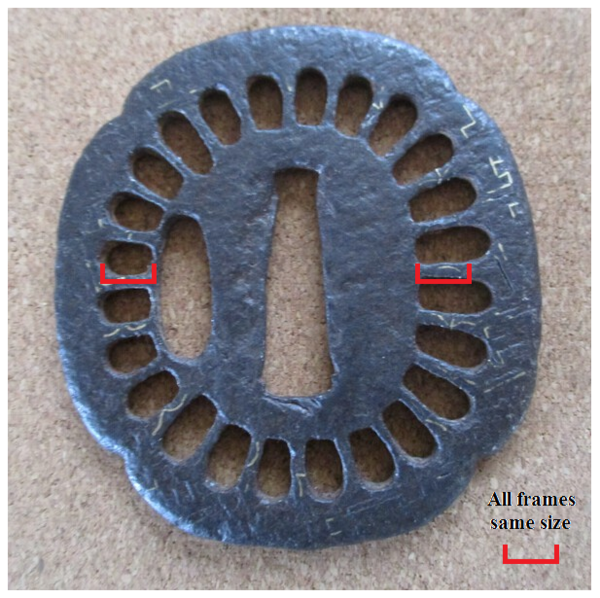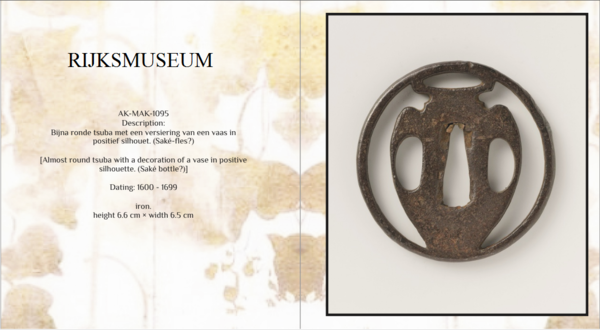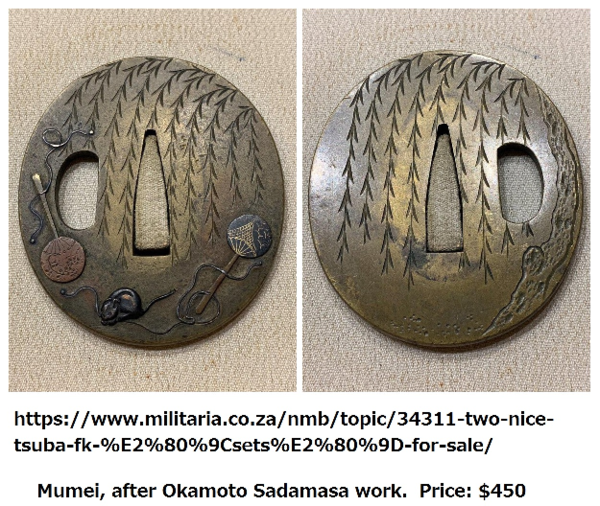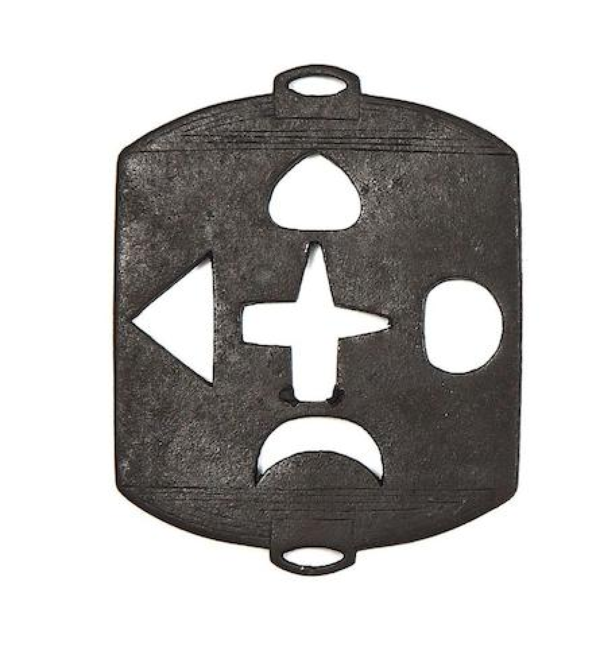-
Posts
3,699 -
Joined
-
Last visited
-
Days Won
100
Content Type
Profiles
Forums
Events
Store
Downloads
Gallery
Everything posted by Spartancrest
-
It is an interesting piece - gets people thinking which is always a good thing . I was wondering if the texture was made intentionally? Like an ishime finish - what stands out to me is the seppa-dai is not corroded/rusted or whichever except around the margins. This would seem deliberate or how else to explain the seppa-dai? The texture reminds me of an old iron anchor sitting at the bottom of the ocean for 50 years - but then once again the seppa-dai even with a copper seppa attached would still deteriorate and it hasn't. Maybe the sword was lost in a desert and ended up sandblasted.
-
Hi Bruno, I have a single katamenuki same pattern as your fist image - you don't happen to know where your example lives?
-
This might fit in this thread- has anyone seem Kozuka and Kogai in nanban before? I just stumbled on this.-https://www.mandarinmansion.com/item/nanban-kogai-and-kozuka-set-futakoromono Now where were these made?
-
Marcos I have seen two guards with four tsuba depicted on them [one was a modern fake or copy] unfortunately I can't lay my hands on the images. Both were certainly not as detailed as your superb sukashi - you should be justifiably proud to own it. Also I have seen some examples of tsuba on kozuka so it looks like almost all types of fittings have been decorated in this way - with one certainty - they are still pretty rare!
-
Marcos, there are a number of tsuba on tsuba already known - but Mr. Ōkawa has not wasted his time, his is a beautiful piece of workmanship. There was a thread earlier in the year on NMB on this very subject -
-
Keith, beautiful Habaki, I like the namban tsuba as well.
-
Hi Ali, there are a lot of good beginners books. I like two of Gary Murtha's books. "Tsuba" [2012] https://www.amazon.com.au/Tsuba-Japanese-Gary-D-Murtha-ebook/dp/B008DL2E7A & "Japanese Sword Guards - Art of War" [2015] https://uedata.amazon.com/Japanese-Sword-Guards-Art-Gary-Murtha/dp/1495115208 hard to find now. And for terminology "Handbook" by Markus Sesko. https://www.amazon.com.au/Handbook-Markus-Sesko/dp/3842364229 I put my own beginners guide out "Tsuba collecting for the Beginner" in 2015. https://www.amazon.com.au/Tsuba-Collecting-Beginner-D-Raisbeck/dp/1389385639 There is another author on NMB, Stephen J. King who has put out his own beginners book based on his own collection. https://www.ebay.com/itm/394045826480 You might be able to see if he has cheaper options. The links may not be the cheapest available but you should be able to find other sites from the descriptions and ISBN Numbers. You may get a few more titles to add to the list from members on NMB. Happy collecting it is a darn addictive hobby.
-
Hi Roger it looks like an attempt at a type called Uchimimikaeshi or Uchikaeshimimi depending on the reference. Unlike your example they are usually made from a thin round or oval plate with the edges turned in one direction while red hot and the 'corners' turned in the opposite. The plate looks thick on yours and it looks like it was a cross shape to start with. Perhaps it was a continental attempt to copy the Japanese style?
-
Temple bell are fairly common, one on auction now https://www.jauce.com/auction/k1019346842 no hole at the top and ura is just a plainer design of the omote. https://www.invaluable.com/auction-lot/iron-tsuba-in-bell-form-depicting-kiyohime-wrappi-293-c-e068d26af7 No details of the ura but it does have a hole at the top. https://br.pinterest.com/pin/650910952377735943/ also no ura view but it appears wan-gata [cupped shape ] http://jameelcentre.ashmolean.org/collection/7/10237/10401 Numerous rimmed designs as well. one here with bell and mask https://www.bonhams.com/auctions/14758/lot/205/ The guard itself is not bell shaped obviously.
-

What are the oldest mountings that have survived?
Spartancrest replied to Misconstrued's topic in Tosogu
As far as tsuba go there are Tôran-kai 倒卵形 [also known as Hoju tsuba] which date back 1,500 years and on occasion turn up on auctions- see https://richardturner.wordpress.com/2009/04/10/toran-kai-倒卵形-tsuba/ https://tsubakansho.com/tag/hoju/ https://www.christies.com/en/lot/lot-1928107 [The Christies catalogue lists 129 as Shitogi but it is Hoju - jewel shape, Kofun refers to a burial mound] https://tosoguya.com/bronze_toran_kei.html - items for sale A link back to 2013 NMB with 'old' tsuba https://www.mandarinmansion.com/glossary/tsuba The earliest known tsuba are the so-called tôran-kai (倒卵形) or "inverted egg shaped" tsuba that date from the Kofun period of circa 300-568 A.D. These were most likely made by sword makers themselves. Metropolitan Museum, accession number 06.310.9. As Piers says, how far back do you want to go? -
Welcome Ali Yes papers do tend to 'inflate' the price - in some cases up to or exceeding ten times the price. Papers can also be found to be wrong. Collect what appeals to you and don't buy just on whether it has papers. Assuming all Tsuba/or Nihonto in general on Ebay are rubbish is also a mistake, there are often very good pieces mixed in with the 'ordinary'. There are numerous auction sites that are far superior to Ebay, many direct from Japan, in fact many items sold on Ebay are also simultaneously sold on these Japanese sites at far lower prices. You should take advantage of NMB's expertise by seeing the reaction to any prospective buy [as you have done] but be cautious you don't give away the auction or you may have extra competition . For me personally, papers are the last thing on my mind when I buy any tsuba, indeed some of my most interesting pieces would never pass Shinsa. But so what!
-
A remarkably similar piece up for auction now- same subjects and layout to Bruno's example but within a different frame and same design as Glen's first two mokko examples [top of this page]
-
The first is Hamano school, the second is Nukagawa school [unsure if this Yasunori was the founder or a later pupil who used part of his name?] The last example is a piece by Iwamoto Konkwan 1755- 1801 and is described as "The poet Narihira unable to take his eyes from a contemplation of Mt.Fuji and its beauties. Narihira was a noble of the ninth century, renowned for his beauty and for his love for Ono-no-Komachi, an equally celebrated poetess. He is frequently depicted riding by her gate, playing the flute."
-
-
Roger I thought at first the hitsu might have been added later but when I checked the size of the openings it is apparent the hitsu was original to the design. The question arises when did hitsu begin to be used on guards? Tachi tsuba never had them originally, so your guard was made 'post' tachi times if Japanese, also the hitsu shape is archaic pointing back in time. However the Korean guards sometimes had openings for a 'bi knife' so it is possible your guard could be Korean but if Korean it is likely made after Japan invaded the region in 1592 and 1597 as the Koreans favored a double edge sword before this time and the guard clearly shows it was for a single edged weapon. Grev, if you change the 'm' to a 'n' you are right.
-
A rare representation of a firearm on a sword fitting - never take a sword to a gun fight! And it can shoot around corners. pretty close to the real thing.
- 1 reply
-
- 6
-

-

-

-
Glen, x2? This one with some gold nunome - no signature, same time, same Bat channel. and I am not mentioning the source.
-
Almost forgot this book has hundreds of tosogu designs. https://www.militaria.co.za/nmb/topic/34294-new-book-on-tosogu-designs/ https://www.amazon.com.au/Album-Designs-Metal-Carving-Chōsen/dp/1034179020 https://www.ebay.co.uk/itm/194113029556 https://www.abebooks.com/servlet/SearchResults?kn=Chosen-gafu&sts=t&cm_sp=SearchF-_-topnav-_-Results&ds=20
-
[One drop missing from the last image from John B above.] Damon you might pick up the difference two little drops of water can make to the 'pot' design. From a sold lot - https://www.japaneseswordbooksandtsuba.com/store/holbrook-tsuba/h272-akao-school# Described as Akao school This design is certainly popular - https://www.christies.com/lot/a-round-iron-kyo-shoami-tsuba-edo-period-5618009/?intObjectID=5618009&lid=1 and back to the full drops on this Christies auction piece. Described as Kyo-Shoami school. So it looks like the design had its own little changes depending on the artist.
-
-
Colin - https://www.jauce.com/auction/h1053036999 https://www.jauce.com/auction/r1049698764 https://www.jauce.com/auction/o1049691586 https://www.jauce.com/auction/v1053611883 - might be a mouse? I have one like this, not sure if this one is still for sale?
-
I agree with Grev. I can't see that your guard has been cut down and there are many guards that even though odd shaped, were designed that way to start with. You have a rare form that is a worthy collection piece. [I love the odd ones!] Did you acquire the piece in Europe? It might have been in a European collection from the 19th/20th century, owners often stuck paper labels on their pieces.
-
This guard is having a bit of an orientation problem, The way the nakago-ana is cut, allows it to be fitted either way around. Not sure this guard fits in with the thread but it does have a cross shape hole? From a Bonhams auction 2010 https://www.bonhams.com/auctions/17945/lot/307/?category=list&length=12&page=1
-
An old thread here with some 'odd' nakago-ana. That first guard looks very roughly finished, perhaps a country blacksmith in China? The one with the undercut scrolls certainly looks namban but that nakago-ana is not for a Japanese blade - Chinese or Korean?
-
The circular 'dots' often represent water drops or dew - understandable on the wave and jar guard as well as the plant leaves one. Perhaps something else on the nakago one? Water is not something you would associate with sword tangs after all. One here in a similar vein to the leaves design.



